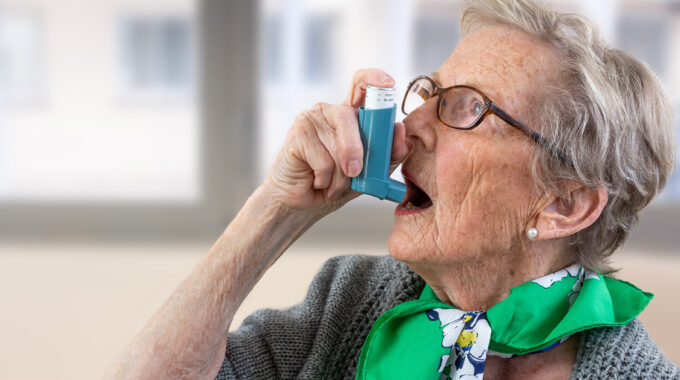
Why So Many Elderly are Nonadherent with their COPD Medications
new study digs into why elderly do not take their COPD medicines as prescribed. Fortunately, the problems are not entirely insurmountable. For many seniors, worthwhile solutions are a phone call away.
How Bad is COPD Medication Nonadherence Among US Elderly?
In 2020, Kaye et al. estimated that slightly more than half of patients are at least 75% adherent.1 This compares favorably to older studies putting adherence at 15 – 30%.2 However, the structure of Kaye’s study would not have detected incorrect inhaler technique. Among elderly patients, as many as 43% of dry powder inhaler users and 75% of pressurized metered-dose inhaler users demonstrated incorrect inhaler technique.3,4 Technique errors are known to develop over time, making it easy for them to go un-recognized.5,6 Regardless of whether COPD medication adherence is 15% or 53%, it is safe to say that patients find it challenging. As one would expect, low adherence in COPD is associated with higher healthcare costs, rehospitalizations, and worse disease control.7
Why Elderly People Struggle with COPD Medication Adherence
To help clinicians gain a deeper understanding of the COPD medication adherence challenge, Jacqueline O’Toole (Johns Hopkins University School of Medicine) and colleagues recently completed a series of structured patient interviews.8 Subjects had an average age of 70, and 93% had high-school degrees or higher. In the interviews, more than half showed signs of at least mild cognitive impairment. Patient-reported sources of non-adherence fell into three main categories: (1) gaps in understanding, (2) forgetfulness, and (3) cost navigation.
Using Home Health to Improve COPD Medication Adherence Among Elderly Patients
In each of the three domains listed above, Medicare-certified home health has services designed to improve medication adherence. When elderly patients are homebound, changes in medication or signs of possible non-adherence can justify a home health episode with Medicare paying 100%.
Gaps in Understanding
Patients reported not realizing that skipping doses made the disease worse. They also complained about not being sure about inhaler techniques, especially when more than one model had been prescribed. Home health nurses visit their patients at home, repeatedly, with visits often lasting 30 minutes each. A relaxed pace in the comforting home environment can reinforce the teaching that has occurred in the exam room. Follow-up visits verify successful adherence or identify the need for more strategies. Home health nurses can also recruit and train family caregivers to help ensure proper inhaler technique.
Forgetfulness
Patients also reported difficulty with forgetfulness. This was especially true with second, mid-day doses. They reported that logs and visual cues had proven effective strategies. Home health nurses routinely help patients implement such strategies. Access to the home and ample time to learn about a patient’s daily routine facilitate the implementation of effective memory strategies. Nurses can help patients develop a log and supervise their progress with that. Something as simple as taping a note to the coffee pot can work for some patients. Other patients may respond to programming recurring alarms into their phones or recruiting family caregivers to call each day.
Cost Navigation
Patients cited cost as a reason for primary non-adherence, underdosing, increasing dosages, and other problematic patterns. Patients were sourcing their inhalers from outside the U.S. Some patients reported that when doctors ordered discontinuation of one inhaler and prescribed another, they kept using both because they didn’t want to “waste” expensive medication. Others reported taking smaller doses to reduce their medication costs. The primary, positive coping strategy reported by patients was receiving samples from their doctors. However, other patients confessed not reporting cost concerns to doctors. Home health nurses can help identify non-adherence and report economic barriers to doctors. In addition to getting free samples, in some cases, there is a potential for another prescription being available to a patient at a lower cost. Nurses can help patients apply to pharmaceutical companies for cost waivers. Home health nurses may additionally explore a patient’s other health costs, possibly finding underutilized coverages for other costs, potentially freeing budget for COPD medication adherence.
See Also: Home Health Rehab Good for COPD
References
- Kaye L, Theye B, Smeenk I, Gondalia R, Barrett MA, Stempel DA. Changes in medication adherence among patients with asthma and COPD during the COVID-19 pandemic. The Journal of Allergy and Clinical Immunology: In Practice. 2020 Jul 1;8(7):2384-5.
- Bogart M, Stanford RH, Laliberté F, Germain G, Wu JW, Duh MS. Medication adherence and persistence in chronic obstructive pulmonary disease patients receiving triple therapy in a USA commercially insured population. International Journal of Chronic Obstructive Pulmonary Disease. 2019;14:343.
- George M, Bender B. New insights to improve treatment adherence in asthma and COPD. Patient Preference and Adherence. 2019;13:1325.
- Khassawneh B, Al-Ali M, Alzoubi K. Handling of inhaler devices in actual pulmonary practice: metered-dose inhaler versus dry powder inhalers. Respir Care. 2008; 53: 324-8.
- Chapman K, Boulet L, Rea R. Physician self-audit of asthma control in primary practice: the implications for implementation of guidelines. Am J Respir crit CareMed. 2004; 169: A362.
- Virchow J, Crompton G, Dal Negro R, et al. Importance of inhaler devices in the management of airway disease. Respir Med. 2008; 102: 10-9.
- Davis JR, Wu B, Kern DM, Tunceli O, Fox KM, Horton J, et al. Impact of nonadherence to inhaled corticosteroid/LABA therapy on COPD exacerbation rates and healthcare costs in a commercially insured US population. Am Health Drug Benefits. 2017;10(2):92–102.
- O’Toole J, Krishnan M, Riekert K, Eakin MN. Understanding barriers to and strategies for medication adherence in COPD: a qualitative study. BMC Pulmonary Medicine. 2022 Dec;22(1):1-8. Pre-released online at: https://bmcpulmmed.biomedcentral.com/articles/10.1186/s12890-022-01892-5.






